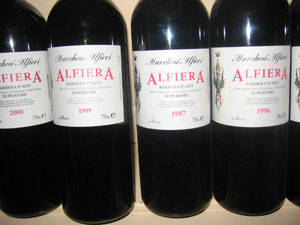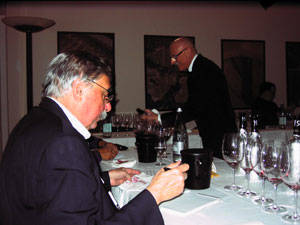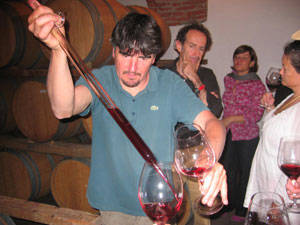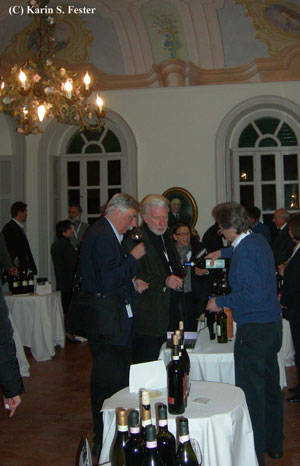La Barbera- The Favorite of the Piedmontese
La Barbera, as it is called by the Piedmontese, is the second most-planted red grape in Italy. The high acidity of the grape makes it an excellent wine to go with food, which makes it a favorite of the Piedmontese. It is said that in Piedmont, people taste Barolo and Barbaresco, but they drink Barbera. If you are invited to someone’s home in Piedmont, chances are you will be offered a glass of Barbera. Because of its longevity, Barbera producers put away some bottles of their wine when a child was born to drink when they became of age.
There is a Barbera for every taste! The wine may be aged in stainless steel, barriques, botti and different combinations of these in varying degrees. The barbera grape is grown in other parts of Italy, but the Piedmontese think of it as their grape. They feel it grows best here and I agree.
When I received the invitation to the seventh annual “Barbera Meeting 2010” being held in Asti, I was only too happy to accept. What made this wine event unusual was that it was open to bloggers. Jeremy Parzen of donbianchi.com created barberameeting.com. The updates of his blog were automatically shifted to the Barbera Meeting blog in order to have immediate information on the event. Jeremy and the bloggers he had working with him were called by the Italian press the Seven Barbera Boys (even though one was a woman). You can go to Jeremy’s blog or to barbera2010.com to see all the blogs about The Barbera Meeting 2010.
We began bright an early on Monday morning with a tasting of 68 wines. The major part of the event which lasted four days was blind tastings of Barbera d’Asti and its particular Nizza subzone, Barbera del Monferrato and Barbera d’Alba. On the first day we tasted Barbera d’Asti 2008, which is now D.O.C.G., 2007, and 2006, both normale and superiore. This gave me my first hint that wines being shown might be a “little too oaky”.
Next there were visits to the wineries. The first visit was to Pescaja and we tasted the wines with the owner Dott. Giuseppe Guido. Dott. Guido wants everything at the winery to be organic. This includes the vegetables that he grows and the animals he raises. He has a unique method of wine making which includes iced CO2 maceration. You can go to his website for an explanation of his method. I still do not understand it.
We tasted Barbera D’Asti D.O.C.G “Soliter” 2008 and Barbera d’Asti D.O.C. Superiore Nizza “Solneri” 2007. The Solneri was way too oaky for me and the other journalists, including my friend and colleague, Tom Maresca. We all liked the Soliter better. Dott. Guido defended the Solneri saying that he did not find it oaky at all. We would face this problem again when we went to Nizza Monferrato.
Then off to Tenuta La Pergola were we tasted a number of Barberas from Asti and Monferrato. I enjoyed all of these wine and there was a good integration of the wine and the wood. They also make a number of good grappas.
Next was Marchesi Alfieri. I had visited this winery last year and wanted to go back again. The enologist Mario Olivero led us in a tasting of Barbera d’Asti from the years
2007, 2006, 2005, 2004, 2003, 2000, 1999 and 1998. Mr. Olivero came to the winery in 1999 and therefore did not make the 1998. The 1998 was aged in botti while the current wines are aged in different size oak barrels. I would have never guessed that the 1998 was 12 years old because it tasted like a much younger wine. The 1999 was also showing very well. Once again, this is an example of a wine maker integrating the wood and the wine. If I had any doubts that Barbera cannot age, this tasting put it to rest.
The day was not over yet. We concluded our first day with a stand up tasting and dinner with the Asti and Alba producers of Barbera at Villa Basinetto.
Next day there was a blind tasting of 50 Barbera D’Asti 2008, 2007 and 2006 (normale and superiore).
Then we went to a lecture on “Spurred Cordon Pruning Method for Barbera Vines”.
As with the oakiness in the wines, I felt it was man intervening in the natural process of the grape. Both Tom Maresca and I asked questions, but were told it was in the best interests of Barbera. They wanted to reduce the acidity in the barbera grape so it could make what they felt was a more important wine. This idea of an important wine would be the theme of the day.
We had lunch and a vertical tasting of Barbera Quorum produced by the Hastae
group. Hastae is the Latin name for the town of Asti. Five producers came together to make this Barbera d’Asti: Braida, Chiarlo, Coppo, Prunotto and Vietti, along with the distiller and grappa maker Berta. They wanted to produce an important wine a “Superbarbera” and a Supergrappa -- and they did.
After lunch it was off to Nizza for a tasting of Nizza Monferrato, a subzone of Barbera d’Asti, where we tasted 25 wines. Here is where things became interesting.
One of the European journalists, Bernard Arnould from Belgium, stated that he found that the wines he had just tasted were too oaky. He questioned the use of barriques and the oak toasty flavors that he found in most of the wines. He was verbally attacked by two of the producers. One said that the journalist did not know anything about wine and the other that there are vast differences in the tastes people have in different countries.
The attack was uncalled for as Mr. Arnould was very precise in his statement. T
second producer was really saying that he uses barriques because that’s the style of wine he thinks people want.
I answered that they seemed to be making wine for the international market. Just because Americans drink cappuccino after lunch and dinner does that mean they do not know about wine. These producers had invited journalists from all over the world. The journalists were telling the producers the same thing--the wines are too oaky. Bloggers are the wave of the future (they have become more important than the print media) and these young people are telling you the same thing--no oaky toasty flavors in your wine. Make the best wine that you can and a wine that you would drink, not a wine just for the market.
The producer Michele Chiarlo said that he agreed with me and that he never made wine for the market. I have been drinking his wines for over almost 30 year and I still enjoy them.
In the Nizza subzone the Barbera has to be aged in wood for at least 6 months. I am not saying do away with the wood. They can age their wines in botti or they can use barriques -- but they should do a better job of integrating the wine with the oak.
At dinner that night we sat with an enologist that told us he made one wine which he drank and another for the market that he would not drink! To top off the evening, it began to snow, and by the time we left it was a winter wonderland outside.
Next morning more wine to taste. This was an easy one -- only 24 wines. They were Barbera del Monferrato 2008, 2007, and 2006 (normale and superiore).
We visited the Cantina iulli winery in Monferrato. I had been here last year and liked the wines, so I wanted to return. The owner and wine maker is Fabrizio iuli. He has an American partner. Fabrizio ages some of his barbera in barriques for 26 months or more but they do not smell or taste of the oak. Some is new oak and some is used. He says that the longer you keep the wine in the barriques the less the oaky flavors will be picked up. The time he keeps his wine in wood depends on the vintage. His 2004 barbera in magnum will not be released until 2013! I liked his barberas when I tasted then last May and they may have been showing even better this time.
Thursday, the last day, was also easy with 29 wines, Barbera d’Alba 2008, 2007 and 2006 (normale and superiore). After lunch there was a stand-up tasting with the Barbera d’Alba producers. This is where the Barbera Meeting came to an end--but not for Tom and me. One of the producers invites us to her winery to taste wine. I looked at Tom and said, “perche no?”
In the large tasting room I looked out the window at the sun shining on the snow covered hills. It was the first time I saw the sun in a week! We tasted the wines with Emanuela Negro of Negro Angelo & Figli. We were both very pleased with the Barbera D’Alba wines that we tasted here. Tom loves grappa and when Emanuela offered us some Tom said “perche no?” The grappa was excellent!
That night I had pizza in what I was told “the best Neapolitan pizza place in Asti”.
I did not think it was very good. The Neapolitan style pizza in New York is much better.
This is the fifth wine event I have gone to that was organized by Well Com and they always do a great job. I would like to thank Marinella, Marta, and Federica for being so helpful, and Annalisa and Marinella Minetti for setting up a great event.
We left Asti at 4:00 in the morning for Torino and then to Rome and on to NY. There was, as usual, a general strike but it did not begin until 10 AM and it did not include international flights. I left Torino at 7:15 for Rome and it only took me 18 hours to get home.









































i-Italy
Facebook
Google+
This work may not be reproduced, in whole or in part, without prior written permission.
Questo lavoro non può essere riprodotto, in tutto o in parte, senza permesso scritto.